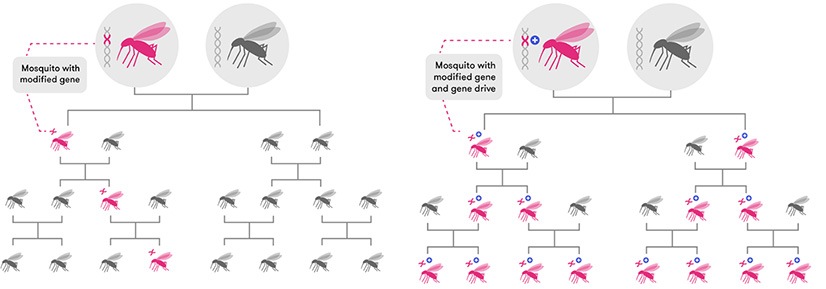Gene drives produce a biased form of inheritance. They overcome normal Mendelian inheritance, where one copy of a gene is inherited from each parent, and greatly increase the chances of an allele passing from a parent to its offspring (Figure 1). This results in the preferential increase in the frequency of a specific genotype over many generations and the entire population may eventually come to possess only that genotype.
Synthetic gene drives are being developed to influence a target population via two primary methods: population suppression or population alteration. A synthetic gene drive that is designed to suppress a population would, over many generations, reduce the number of individuals within a population following its introduction—possibly to zero. A synthetic gene drive designed to alter some characteristic of a population would involve a modified genetic element that is then spread throughout the population, for example to confer resistance or immunity to a certain parasite or disease.
A number of basic criteria are required for a synthetic gene drive to work. Firstly, the organism must reproduce sexually. This means that viruses, bacteria, many plants and some animals which use other means to reproduce cannot be altered in this way. Secondly, to be practical, the organism must reproduce rapidly. Elephants and trees with long generation times are therefore not ideal targets whereas insects, some plants and small vertebrates such as rodents and fish could be successful candidates. In addition, the organism must also be able to be transformed, and the trait of interest must have a simple genetic basis.
Whilst synthetic gene drives could technically be used in humans, we are unlikely candidates due to the combination of the complex ethical issues this would raise and the lack of efficacy from a practical perspective. Our long generation times would mean a gene drive-mediated change would take hundreds of years to spread throughout a human population. In most jurisdictions any research in this area would also be heavily regulated by existing legislation; in Australia extensive coverage would be provided by the Research Involving Human Embryos Act 2000 and the Prohibition of Human Cloning Act 2002.

© 2025 Australian Academy of Science